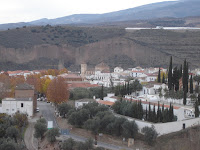by Robert Bovington
| Ohanes |
Chris Stewart, in his best-selling book 'Driving over Lemons' tells a riveting tale of life on a remote farm in the Alpujarras. When we moved to Spain my wife and I, for a number of practical reasons - like not wanting the hard work that comes with working a farm, decided to live on the coast. However, intrigued by Chris Stewart's book, we started to regularly go on trips into the Alpujarras which are only an hour's drive away from our home in Roquetas de Mar. The Alpujarras has become one of our favourite places.
 |
| Ugíjar |
The whole region is special and one of great natural beauty. The valleys of the western Alpujarras are among the most fertile in Spain, though the steep nature of the terrain means that they can only be cultivated in small fields, so that many modern agricultural techniques are impractical. However, that adds to the charm of the area - at least for us idle buggers who don't have to work the fields. On a recent walk along the GR7 footpath, near the delightful little town of Válor, I saw a farmer ploughing the side of a hill using a horse and plough!
 |
| sheep rearing nr Nechite |
Many peoples tried to conquer this mountainous area but it was finally the Moors who succeeded in settling in the Alpujarras. They were the only owners of this region for hundreds of years and even after the fall of Granada in 1492 they were allowed to remain there. Only after the Morisco Revolt of 1568 were these enterprising people forced to leave.
The influence of the Moorish population can be seen in the agriculture, the local cuisine, the local carpet weaving and the numerous Arabic place names.
The houses of the Alpujarras are quite charming with little chimneys sticking out as a reminder that the winter evenings can be a tad chilly. The houses are built of stone, adobe and clay and their façades whitewashed. The distinct cubic construction of these buildings is reminiscent of Berber architecture in Morocco's Atlas Mountains. The steepness of the land means that the houses in the villages seem to be piled on top of one another, and their characteristic flat roofs, distinctive roofed chimneys, and balconies - tinaos - extending across the steep narrow streets give them a unique and picturesque appearance - from a distance they appear to cling precariously to the mountainside.
There are many villages in the region, the largest being Lanjarón, Órgiva, Ugíjar, Laujar de Andarax and Berja. All are situated at a considerable elevation but Trevélez, at 1476 metres above sea level, is the highest town in Spain.
Most of the villages are delightful places to live or visit but the three white villages in the gorge of the Rio Poqueira - Pampaneira, Bubión and Capileira -have become recognised tourist destinations and are very popular with walkers.
There are many other traditional villages of similar appearance including Mecina Bombarón and Laroles in Granada province together with the Almerian villages of Ohanes, Padules and Alboloduy.
 |
| Pampaneira |
 |
| Trevélez jámon |

No comments:
Post a Comment